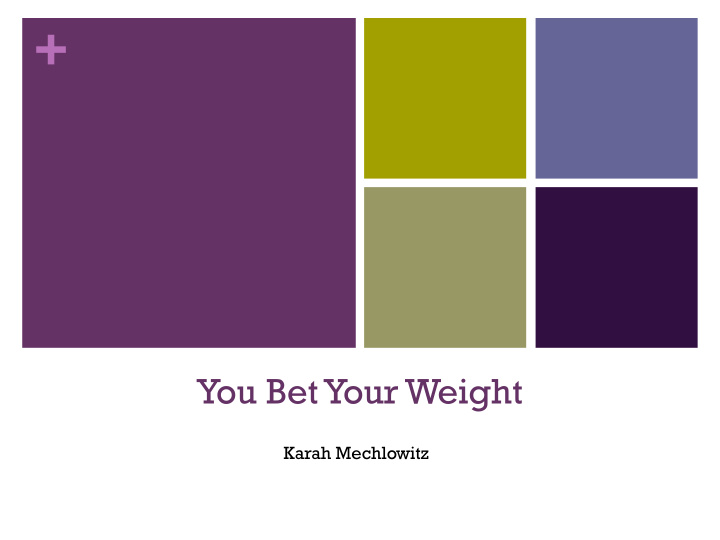



+ You Bet Your Weight Karah Mechlowitz
+ What to Expect for Today n Introduction to macronutrients n Breakdown of each macronutrient n Ways to track macronutrients n Wrap up
+ What are the macronutrients? Carbohydrates Protein Fat
+ Food Guide Pyramid vs. MyPyramid vs. MyPlate Food Guide Pyramid A Guide to Daily Food Choices Fats, Oils, & Sweets KEY USE SPA RING L Y Fat (naturally occurring Sugars and added) (added) These symbols show fat and added sugars in foods. Milk, Yogurt, Meat, Poultry, Fish, & Cheese Dry Beans, Eggs, Group & Nuts Group 2-3 SE RVING S 2-3 SE RVING S Vegetable Fruit Group Group 3-5 SE RVING S 2-4 SE RVING S Bread, Cereal, Rice, & Pasta Group 6-11 SE RVING S Source: U.S. Department of Agriculture/U.S. Department of Health and Human Services Food Guide Pyramid MyPyramid MyPlate (1992) (2005) (2010)
+ Macronutrient Distribution MyPlate Acceptable Macronutrient (2010) Distribution Ranges (AMDR)
+ Carbohydrates n Rule #1: Carbohydrates (CHO) are not bad for you! n They are the most important source of energy in the body. n Types of CHO: n Simple n Natural sugars n Added sugars n Complex
+ What IS a whole grain? Examples: • Barley • Wheat • Wild rice • Quinoa • Oats • Rye • Farro • Wheat • Corn (including popcorn!) Whole grain = all of the original Refined grain = removal of bran kernel - germ, bran, and endosperm and germ *Note: Most refined grains are enriched, a process that adds back iron and B-vitamins (micronutrients)
+ How much carbohydrates should you have? n 45-65% of total daily calories should come from CHO/3-5 servings per day. n 1 serving = 1 slice of bread, ½ cup cooked rice or pasta, 1 cup ready-to-eat cereal, 3 cups popped popcorn… n Make half of these CHO whole grains. n Looking at MyPlate, what are the sources of CHO?
+ Protein n Sources of protein: n Animal: more bioavailable n Plant n Subgroups n Seafood n Meats, poultry, and eggs n Nuts, seeds, and soy products n Legumes (beans and peas)
+ What do protein foods provide? (in addition to protein & iron) Protein Source Provided Nutrient Meats Zinc Poultry Niacin (B vitamin) Seafood Vitamin B 12 , vitamin D, omega 3 fatty acids Eggs Choline Nuts and seeds Vitamin E Soy products & legumes Copper, manganese, fiber Note: Processed protein foods can be high in salt, saturated fat, and preservatives.
+ How much protein? n 10-35% of total daily calories should come from protein n 3-4 ounces of protein per meal (palm sized portion) n MORE of these sources of protein: n Chicken n Lean ground turkey n Fish and shellfish (recommend at least 8 ounces/week ) n Lean ground beef n Flank steak n Nuts and seeds (small handful, unsalted) n Eggs ( including the yolk!) n Legumes
+ Fat n Not all fats are created equal! n Dietary fats are found in both animal and plant foods n Help with absorption of vitamins A, D, E, and K n Can be sources of omega 3 and omega 6 fatty acids n All dietary fats are a mix of polyunsaturated, monounsaturated, and saturated fatty acids n Oil vs. fat n Oil: higher proportion of PUFA and MUFA à liquid n Fat: higher proportion of SFA or trans fat à solid
+ Fatty Acid Profiles (AKA not all fats are created equal!)
+ Quantity and Quality of Fat n 20-35% of total daily calories should come from fat. n Oils should replace solid fats. n Rich sources of oils: n Vegetable oils n Margarine n Mayonnaise n Salad dressings n Avocado n Nuts and nut butters
+ A word on fiber n Benefits of fiber: n Helps maintain bowel health n Can lower cholesterol levels n Can help control blood sugar levels n Can increase feelings of satiety n Sources of fiber: n Beans and peas n Vegetables n Oats n Apples n Whole wheat flour n Nuts n It is NOT added back during the enrichment process of grains.
+ How can you track your macronutrients? My Fitness Pal
+ How can you track your macronutrients? Lose It!
+ Quick Word on Fruits, Vegetables, and Dairy n Fruits n Recommend 2 cups per day n Can be fresh, frozen, canned, or dried n Contribute many vitamins & minerals n Vegetables n Recommend 2.5-3 cups per day n Can be fresh, frozen, or canned n Include a variety n Dairy n Recommend 3 cups per day n Include more low-fat or skim sources Aim for half of your plate being fruits or vegetables!
+ What is the best diet to lose weight? Paleo diet? The Zone diet? Atkins diet? Mediterranean diet? Weight Watchers? DASH diet? South Beach diet?
+ Trick Question! n The “best” diet to lose weight is entirely up to you. n Remember: what works for one person may not work for another. n An overall healthy eating pattern is the goal. n This includes more: This limits:
Thank you! + Questions?
Recommend
More recommend